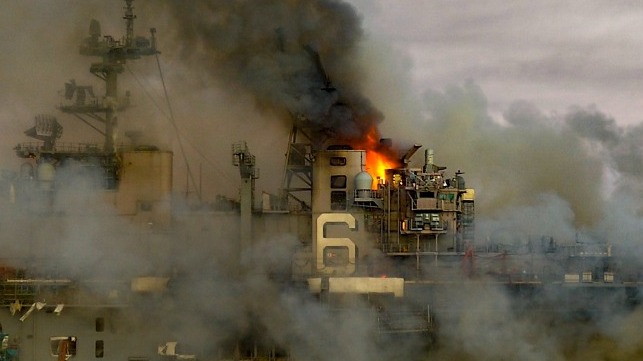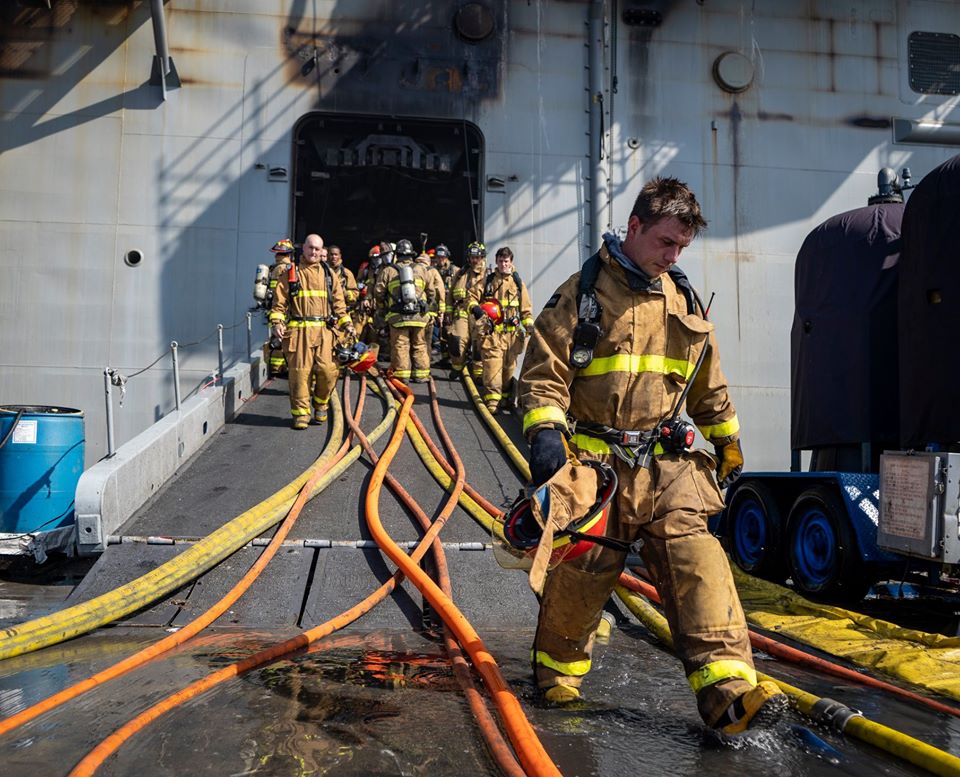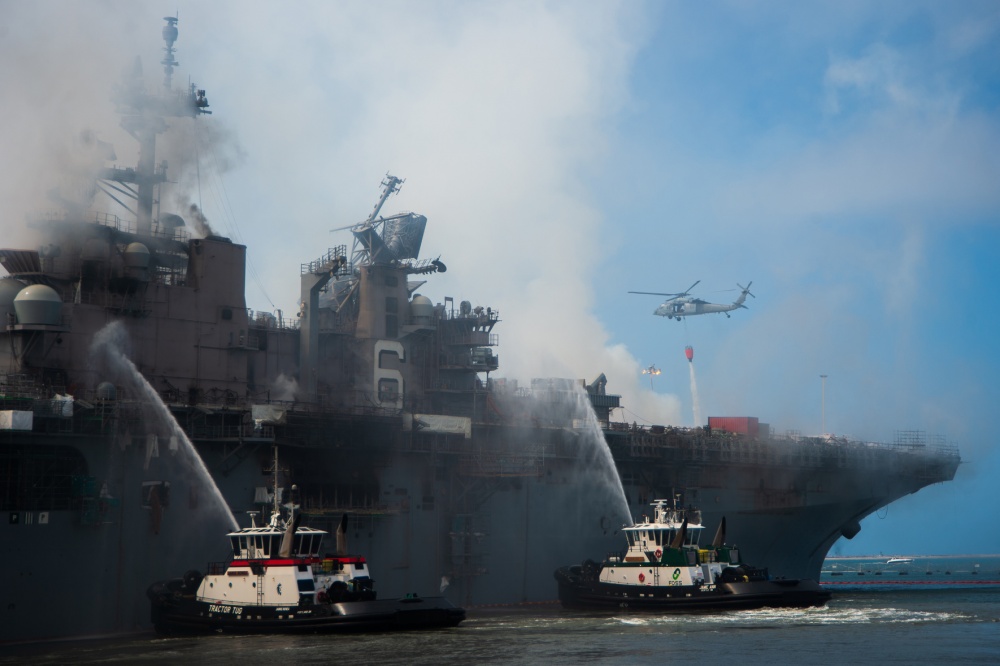Report: Failed Firefighting Response Led to Loss of $1.2B Amphib

When a crewmember intentionally started a fire aboard the amphib USS Bonhomme Richard on July 12, 2020, it took a 500-strong team of U.S. Navy and civilian firefighters five days to put out the blaze. The $1.2 billion vessel ultimately had to be scrapped, but at the time, Navy leadership valorized the crew's heroic efforts to save her. As Chief of Naval Operations Adm. Mike Gilday put it the week after the fire, "this was their ship, and they would walk point on every firefighting mission. Most had to be ordered . . . to go home at some point and get some rest.”
However, an internal report that leaked to media outlets this week suggests that it may have been the crew - and the officers in their chain of command - who sealed Bonhomme Richard's fate.
"Although the fire was started by an act of arson, the ship was lost due to an inability to extinguish the fire," concluded an investigation led by Vice Adm. Scott Conn, formerly head of 3rd Fleet. "In the 19 months executing the ship’s maintenance availability, repeated failures allowed for the accumulation of significant risk and an inadequately prepared crew, which led to an ineffective fire response.”
The report lays out an astonishing sequence of failures, from the crew's firefighting training to the industrial hygiene precautions during Bonhomme Richard's yard period to the delayed reaction on the day of the fire. The common thread was a failure of leadership, running all the way up to the flag-officer level, Conn found.
When the fire started in a lower vehicle hold at about 0800 hours on July 12, 2020, the first sailor who noticed smoke did not report it. The individual spotted a "hazy, white fog" at about 0810 but did not smell smoke and made no mention of the development. The engineering duty officer learned of a report of smoke in the hold from a civilian contractor at about 0815, and amidst general confusion, a shipwide announcement over the 1MC did not go out until 0820.
The crew began to mount a firefighting response at about 0824. However, the initial attack was disorganized and confused, in part because no one had a solid grasp on which firefighting systems were operable. Just 29 out of the 216 firefighting stations on board were working at the time of the fire: many were shut off or inoperable due to the ongoing yard work and a handful near the fire were apparently sabotaged. The first response crews did not reach the seat of the fire or establish effective fire boundaries, and the blaze began to spread. The command and control nerve center for a major casualty, DC Central, was missing in action until the spread of the fire forced its personnel to evacuate; its watchstanders were never heard over the 1MC.
Critically, no one used the fixed AFFF firefighting foam system for the Lower V hold, "in part because maintenance was not properly performed to keep it ready and in part because the crew lacked familiarity with capability and availability."
According to Conn's report, "no member of the crew interviewed considered this action or had specific knowledge as to the location of the button or its function."
USN
As a result of this confusion, no extinguishing agents were applied to the seat of the fire for the entirety of the first day, "and the opportunity to do so was lost once the fire spread beyond the perimeter of Lower V and across the entire ship." At that point, with scaffolding and yard equipment blocking passageways and hatches, the difficulty of the firefighting effort increased rapidly. A lack of coordination between civilian FedFire teams and Navy firefighters - with siloed parallel command structures for each - contributed to an ineffective response over the next five days.

USN
Like so many marine casualties, the seeds were sown long before the event, Conn found. His team faulted the vessel's commanding officer for creating an "environment of poor training, maintenance and operational standards that directly led to the loss of the ship." He pointed further up the chain of command as well, naming five admirals with regional or national responsibility for maintenance activities.
In his conclusion, Conn noted that the Navy has been through this before, and not that long ago. The arson aboard the sub USS Miami in 2012 resulted in a long list of lessons-learned, codified in the so-called 8010 Manual. Many of Bonhomme Richard's sailors were not familiar with this document at all, and they were not alone.
"In the last 5 years, policy changes and corrective actions to address fire safety were inconsistently implemented or failed to be implemented across the Navy maintenance organization," Conn wrote. "Additionally, there was a lack of procedural compliance and effective oversight within the Naval Sea Systems Command (NAVSEA), Navy Installations Command, and Naval Surface Force Pacific Fleet."
In a statement released Wednesday, the Navy acknowledged the report's findings. It said that the commander of U.S. Pacific Fleet will be handling administrative and disciplinary actions relating to military members who were implicated in Conn's investigation.
“The loss of this ship was completely preventable,” said Vice Chief of Naval Operations Bill Lescher. “And the Navy is executing a deliberative process that includes taking appropriate accountability actions with respect to personnel assigned to Bonhomme Richard and the shore commands designed to support the ship while moored at Naval Base San Diego.”
The service also acknowledged deeper problems with the Navy's preparedness for shipboard fires during maintenance. A broader "Major Fires Review" ordered in January found a range of systemic issues, and the service is working to drive uptake of its recommendations across the fleet.
"The Major Fires Review revealed that ineffective learning, the persistence of underlying weaknesses in shipboard watchstanding standards, hazardous and combustible material stowage, and training were the primary issues contributing to a lack of enduring change and in shipboard fires," the Navy said in a statement.

